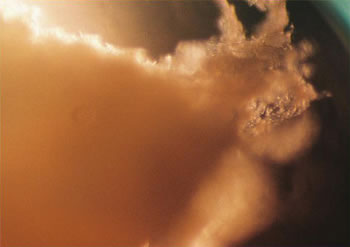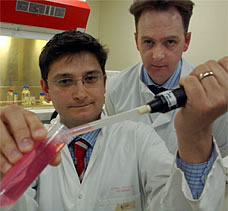Science Fiction
Dictionary
A B C D E F G H I J K L M N O P Q R S T U V W X Y Z
World's First Artificial Human Liver Grown In Lab

The world's first artificial liver has been grown from stem cells by British scientists. The resulting "mini-liver" is the size of a small coin; the same technique will be further developed to create a full-size liver. Unlike other efforts to grow liver cells, this new technique allows researchers to actually duplicate the structure of the organ.

(Artificial liver tissue)
The mini-liver is useful as it is; within two years it can be used to test new drugs, reducing the number of animal experiments as well as providing results based on a human (rather than animal) liver.
Researchers Dr. Colin McGucklin, Professor of Regenerative Medicine at Newcastle University, and Dr. Nico Forraz, Senior Research Associate and Clinical Sciences Business Manager at Newcastle University, say that pieces of artificial liver could be used to repair livers injured by injury, disease, alcohol abuse or other causes in the next five years. These artificial livers could also be used outside the body in a manner analogous to the dialysis process used to keep alive patients whose kidneys have failed.
In fifteen years time, entire livers could be grown in the lab and then be transplanted into human beings.

(Artificial liver tissue)
The stem cells used by Drs. McGucklin and Forraz in this research are gathered from umbilical cords ("cord blood"), seen by some as a more ethical alternative to stem cells created from human embryos.
The cells are then placed in a Bioreactor, a device developed by NASA to simulate the weightless environment of space. The cells are situated in a growth medium that is constantly rotated, putting the cells in an endless state of free-fall. Ordinary cell growth in a nutrient medium in a dish does not provide a culture environment that supports three-dimensional tissue assembly. Epithelial cells without a three-dimensional assembly environment lack the proper clues for growing into the variety of cells that make up a particular tissue. Epithelial cells are the basic cells that differentiate tissue into specific organ functions. In a rotating Bioreactor, scientists can fool cells into behaving as though they are in a body.
The need for an additional source of livers for transplantation is acute. In the United States, more than 17,000 people are currently on liver transplantation lists, according to the United Network for Organ Sharing (UNOS).
The advent of the artificially grown liver for transplantation was one of the core issues discussed by science fiction writer Larry Niven in his 1968 novel A Gift from Earth. In the novel, a distant space colony develops a dictatorial government that uses "Implementation" - the practice of gathering criminals and dissidents and then taking out their usable organs for transplants. This practice is disturbingly similar to particular aspects of the penal system in modern China, which also provides transplant organs from condemned criminals. A ship from Earth destroys this system with a shipment of artificially grown organs:
I'm sure we can offer free access to the heartbeasts and liverbeasts and so forth. For a while your colonists will have to come up to the Hospital to get treatment with the ramrobot symbiots, but eventually we can build culture tanks in Gamma and Delta and Eta."
(Read more about Larry Niven's artificially grown organs)
As the need for transplanted organs has grown more acute in our present-day world, the pressure to supply this need from condemned criminals has also grown, just as Niven predicted. Niven also coined the term "organlegging" to describe the practice of stealing another person's organs and selling them for transplantation.
Read about these other science-fictional advances in medicine:
- Lab Mice Unexpectedly Regenerate Limbs, Organs
Mice bred to contract lupus are found to regrow limbs and organs. - Bionic Arm Uses Neuro-Engineering
Scientists attached a unique bionic arm to an injured electrician's left shoulder - just like Steve Austin. - Young Blood Found To Revive Aging Muscles
Physicians have been studying specialized cells called satellite cells, which are the stem cells in muscles.
Read an early article about liver tissue grown in a lab and Bioreactors. Thanks to reader Bob Fandrich for the tip on the story.
Scroll down for more stories in the same category. (Story submitted 10/31/2006)
Follow this kind of news @Technovelgy.| Email | RSS | Blog It | Stumble | del.icio.us | Digg | Reddit |
Would
you like to contribute a story tip?
It's easy:
Get the URL of the story, and the related sf author, and add
it here.
Comment/Join discussion ( 2 )
Related News Stories - (" Medical ")
Bone-Building Drug Evenity Approved
'Compounds devised by the biochemists for the rapid building of bone...' - Edmond Hamilton, 1932.
BrainBridge Concept Transplant Of Human Head Proposed
'Briquet’s head seemed to think that to find and attach a new body to her head was as easy as to fit and sew a new dress.' - Alexander Belaev (1925)
Natural Gait With Prosthetic Connected To Nervous System
'The leg was to function, in a way, as a servo-mechanism operated by Larry’s brain...' - Charles Recour, 1949.
Brain Implant Is Able To Capture Your Inner Dialogue
'So you see, you can hide nothing from me.'
Technovelgy (that's tech-novel-gee!) is devoted to the creative science inventions and ideas of sf authors. Look for the Invention Category that interests you, the Glossary, the Invention Timeline, or see what's New.
Science Fiction
Timeline
1600-1899
1900-1939
1940's 1950's
1960's 1970's
1980's 1990's
2000's 2010's
Current News
Leader-Follower Autonomous Vehicle Technology
'Jason had been guiding the caravan of cars as usual...'
Golf Ball Test Robot Wears Them Out
"The robot solemnly hit a ball against the wall, picked it up and teed it, hit it again, over and again...'
Boring Company Vegas Loop Like Asimov Said
'There was a wall ahead... It was riddled with holes that were the mouths of tunnels.'
Rigid Metallic Clothing From Science Fiction To You
'...support the interior human structure against Jupiter’s pull.'
Is The Seattle Ultrasonics C-200 A Heinlein Vibroblade?
'It ain't a vibroblade. It's steel. Messy.'
Roborock Saros Z70 Is A Robot Vacuum With An Arm
'Anything larger than a BB shot it picked up and placed in a tray...'
A Beautiful Visualization Of Compact Food
'The German chemists have discovered how to supply the needed elements in compact, undiluted form...'
Bone-Building Drug Evenity Approved
'Compounds devised by the biochemists for the rapid building of bone...'
Secret Kill Switch Found In Yutong Buses
'The car faltered as the external command came to brake...'
Inmotion Electric Unicycle In Combat
'It is about the size and shape of a kitchen stool, gyro-stabilized...'
Grok Scores Best In Psychological Tests
'Try to find out how he ticks...'
PaXini Supersensitive Robot Fingers
'My fingers are not that sensitive...'
Congress Considers Automatic Emergency Braking, One Hundred Years Too Late
'The greatest problem of all was the elimination of the human element of braking together with its inevitable time lag.'
The Desert Ship Sailed In Imagination
'Across the ancient sea floor a dozen tall, blue-sailed Martian sand ships floated, like blue smoke.'
The Zapata Air Scooter Would Be Great In A Science Fiction Story
'Betty's slapdash style.'
Thermostabilized Wet Meat Product (NASA Prototype)
There are no orbiting Michelin stars. Yet.
